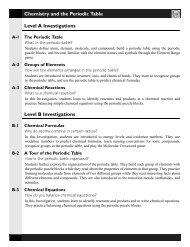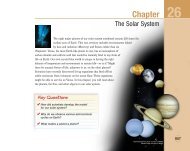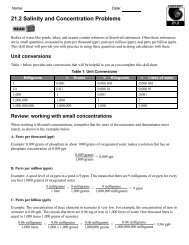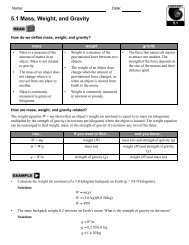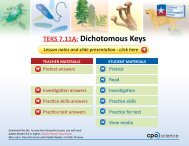18.2 Nicolas Steno - CPO Science
18.2 Nicolas Steno - CPO Science
18.2 Nicolas Steno - CPO Science
- No tags were found...
Create successful ePaper yourself
Turn your PDF publications into a flip-book with our unique Google optimized e-Paper software.
Page 1 of 2<strong>18.2</strong> <strong>Nicolas</strong> <strong>Steno</strong><strong>18.2</strong><strong>Nicolas</strong> <strong>Steno</strong> was a keen observer of nature at a time when many scientists were content to learnabout the world by reading books. Through dissection, <strong>Steno</strong> made important advances in the field of medicine.Later he applied his observational skills to the field of geology, identifying three important principles thatgeologists still use to determine the order in which geological events occurred.<strong>Steno</strong>’s childhood<strong>Nicolas</strong> <strong>Steno</strong> was born in1638 in Copenhagen,Denmark. He became ill at agethree and spent most of histime indoors until age six. Hesaw few children, but spenttime listening to adults discussreligion. Religion laterbecame an important part ofhis life.<strong>Steno</strong>, the son of a goldsmith,had skillful hands like his father. However, his skillwas not in making jewelry. He was an expert indissecting animals to learn about anatomy. He wasfascinated by the structure of living things.The young scientistWhen <strong>Nicolas</strong> was not yet ten years old, his fatherdied. He spent his teen years living in Copenhagenwith a half-sister and her husband. <strong>Steno</strong> was smart,curious, and a good listener. He gained the attention oftwo scholars in Copenhagen.The first scholar, Ole Borch, welcomed <strong>Steno</strong> into hisalchemy laboratory. There, <strong>Steno</strong> watched assediments settled out of liquid solutions. He thought itwas interesting that even when the bottom of the jarwas bumpy, the sediments formed a smooth horizontallayer on top of the bumpy surface.Thomas Bartholin, a famous anatomist from theUniversity of Copenhagen, also mentored <strong>Steno</strong>.Perhaps through this friendship, <strong>Steno</strong> developed akeen interest in dissection and anatomy. In 1660, heleft Denmark to study medicine at the University ofLeiden in the Netherlands. There, through carefuldissection of mammals, he made discoveries related toglands, ducts, the heart, brain, and muscles.A shark’s tooth unlocks a mysteryIn 1665, <strong>Steno</strong> moved to Italy. The following year,fishermen there captured a great white shark. TheItalian Duke Ferdinand sent the head to <strong>Steno</strong> fordissection. <strong>Steno</strong> carefully observed the shark’s teeth.They looked like glossopetrae or “tongue stones,”common stony items found inside rocks.While we now know that these tongue stones arefossilized remains of living things, in <strong>Steno</strong>’s timemany people believed tongue stones either grew insiderocks, fell from the sky, or even fell from the Moon.<strong>Steno</strong> suggested a different explanation for the tonguestones. He said they had once been actual shark teeth!Then <strong>Steno</strong> started to think about how a solid object,like a shark tooth, could get inside another solidobject, like a rock.Three important principlesBased on his work, <strong>Steno</strong> came up with threeimportant principles of geology.• The principle of superposition says that layers ofsediment settle on top of each other. The oldest layersare on the bottom and the more recent layers are ontop.• The principle of original horizontality says thatsedimentary rock layers form in horizontal patterns,even if they form on a bumpy surface.• The principle of lateral continuity says that sedimentlayers spread out until they reach something that stopsthe spreading.<strong>Steno</strong> explained that the shark teeth had been in softsediment that eventually hardened into a layer of rock.<strong>Steno</strong> used his principles to write a book about thegeology of a region of Italy called Tuscany. Eventoday, geologists use <strong>Steno</strong>’s principles to determinethe order in which geologic events occurred.Father <strong>Steno</strong>In 1675, <strong>Steno</strong> gave up science to become a priest. Hedied in 1686 at the age of 48. In 1988, Pope John PaulII beatified <strong>Steno</strong>, the first step in the process ofnaming someone a saint. Today, the <strong>Steno</strong> Museum inDenmark and craters on both Mars and the Moon bearhis name.
Page 2 of 2Reading reflection1. Name and briefly describe the three important principles of geology developed by <strong>Steno</strong>.<strong>18.2</strong>2. How did most people in the 1600s explain the origin of fossils?3. How did <strong>Steno</strong> explain the existence of tongue stones or shark teeth in rocks?4. How did <strong>Steno</strong>’s medical background and skills help him with his geological discoveries?5. Observing is very important in science. What things do you like to observe? What have you learned throughobservation?6. Research: <strong>Steno</strong>’s father was a goldsmith and one of his teachers was interested in alchemy. What does agoldsmith do? What is alchemy? How could these two fields have been helpful to <strong>Steno</strong>’s work?



